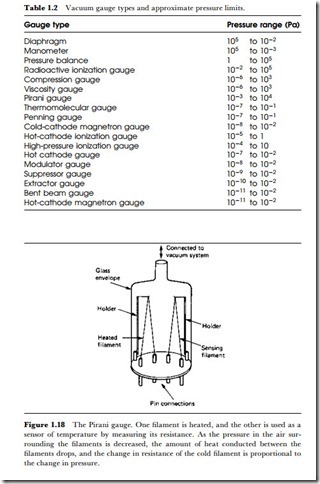Low gas pressures
The measurement of low gas pressures is a much more specialized subject. Pressures that are only slightly lower than the atmospheric pressure of around 100 kPa can be sensed with the same types of devices as have been described for high pressures. These methods become quite useless, however, when the pressures that need to be measured are very low, in the range usually described as ‘vacuum’. Pressure sensors and transducers for this range are more often known as vacuum gauges, and many are still calibrated in the older units of millimetres of mercury of pressure. The conversion is that 1 mm of mercury is equal to 133.3 Pa. The high-vacuum region is generally taken to mean pressures of 10-3 mm, of the order of 0.1 Pa, although methods for measuring vacuum pressures generally work in the region from about 1 mm (133.3 Pa) down. Of some 20 methods used for vacuum measurement, the most important are the Pirani gauge for the pressures in the region 1 mm to 10-3 mm (about 133 Pa to 0.13 Pa), and the ion gauge for significantly lower pressures down to about 10-9 mm, or 1.3 x 10-7 Pa. A selection of measuring methods is illustrated in Table 1.2.
• All vacuum gauge heads need recalibration when a head is replaced.
The Pirani gauge, named after its inventor, uses the principle that the thermal conductivity of gases decreases in proportion to applied pressure for a wide range of low pressures. The gauge (Figure 1.1S) uses a hot wire element, and another wire as sensor. The temperature of the sensor wire is deduced from its resistance, and it is made part of a resistance measuring
bridge circuit identical to that used for resistive strain gauges. As the gas pressure around the wires is lowered, less heat will be conducted through the gas, and so the temperature of the sensor wire will drop, since the amount of heat transmitted by convection is negligible (because of the arrangement of the wires) and the amount radiated is also very small because of the comparatively low temperature of the ‘hot’ wire. Commercially available Pirani gauges, such as those from Leybold, are robust, easy to use, fairly accurate, and are not damaged if switched on at normal air pressures. They can be obtained calibrated for various pressure ranges, each with a range (high/low) of around 104.
